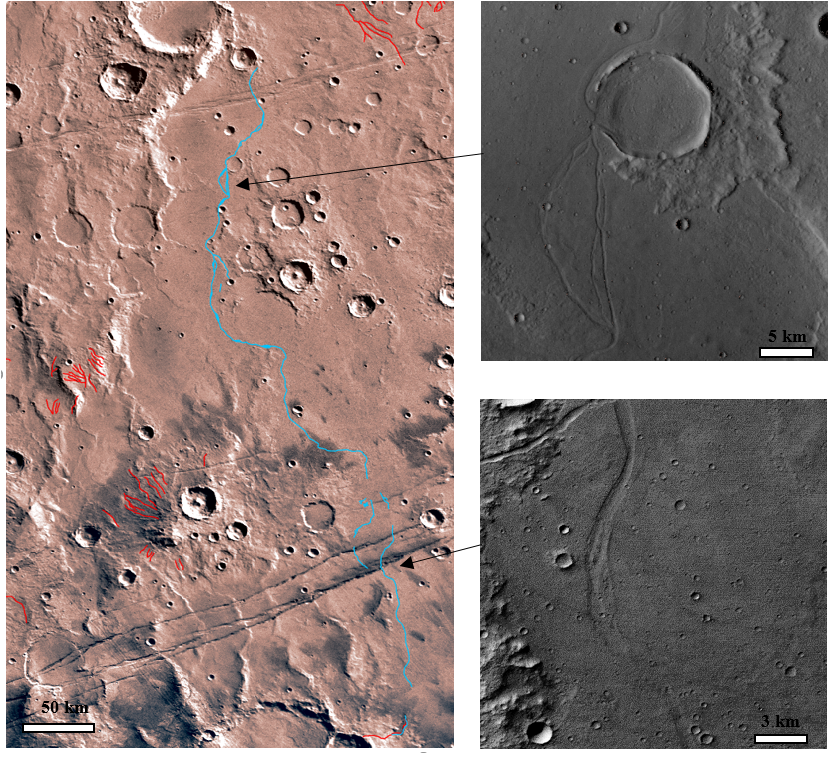The Odd Lengthy Valleys of the Early Hesperian Volcanic Unit Mars
- European Space Agency, Noordwijk, Netherlands (rickbir.bahia@esa.int)
The Odd Lengthy Valleys of the Early Hesperian Volcanic Unit Mars. R. S. Bahia1, 1European Space Agency (rickbir.bahia@esa.int)
Introduction: Martian valley networks are evidence for surface run-off and past water cycles on ancient Mars [e.g. 1–3]. There is still great uncertainty in the duration, intensity and surface conditions that led to valley formation. However it is generally agreed that most formed as a result of precipitation-fed (most likely snowfall) fluvial [4] and subglacial melt water incision [5], with some forming via sapping erosion. Precipitation-fed networks have characteristics that resemble terrestrial systems; e.g., the valleys generally originate at or adjacent to drainage divides [6], some of which have numerous tributaries with drainage densities comparable to low-order terrestrial valley systems [3]. Subglacial valleys have large width-to-depth ratios and undulating long. profiles [e.g., 7]. Qualitative observational characteristics typical for subglacial channels are an abrupt source and termination, stepped long. profiles, a semi-uniform width and no meter scaled tributaries [e.g., 7].
Most valleys incise Noachian to Early Hesperian aged surface [e.g., 3], indicating this was the period of peak fluvial activity. The morphology of these valleys likely reflects the intensity and duration of fluvial activity at their time of formation, with Early Noachian to Mid-Noachian (4.15 – 3.85 Ga) networks draining into local lows and being relatively short (≤100 km long) and Late Noachian/Early Hesperian surfaces displaying regionally-integrated valley networks across the Southern Highlands, likely indicative of a peak in fluvial activity [e.g., 4].
In a recent valley mapping effort using High/Super Resolution Stereo Colour Imager (HRSC) images (~ 25 m per pixel), a small number of lengthy single-thread valleys, that a morphologically dissimilar than the majority of valley networks, were identified. This study aims to perform detailed morphological analysis of these valleys in order to better understand their origin. Here I present the initial observations of these valleys.
Data and Methods: Valley were identified in ESA Mars Express Orbiter – High/Super Resolution Stereo Colour Imager (HRSC) images (~ 25 m per pixel) and manually mapped using the polyline function within ArcMap 10.2.1, defined under analogous characteristics as those of previous studies [e.g., 3, 8]; i.e., sublinear features dividing into small branches upslope and become singular downstream whilst slightly increasing in size. CTX (Context Camera – ~5m per pixel) images were used to perform detailed morphological analysis. Drainage density was determined as the total length of valleys within a set radius of 235 km for each output raster cell (in accordance with [3]) using the ArcMap Spatial Analyst - Line Density tool.
A combination of HRSC digital elevation models (DEM) and the Mars MGS MOLA - MEX HRSC Blended DEM Global 200m v2 [9] was used to obtain elevation data. In order to determine the relative ages and geological settings of the mapped valleys, the Tanaka et al. (2014) digital global map of Mars was used [10]. The ages for these surfaces are determined from crater density counts.
Results: At present these valleys have been predominantly identified incising Early Hesperian aged units, specifically those with volcanic origins. The source and termination of these valleys is generally abrupt. They have almost no tributaries and are essentially comprised of one lengthy main valley. For example, the valley presented in Figure 1 has a main valley length of 332.2 km, a total valley length of 674.9 km, and very low drainage densities (max. 0.004 km-1). The branches of valleys that add to the main valley length (resulting in a higher total valley length) do not appear to be tributaries, but areas in which the main valley has become anastomosed and disconnected in areas due to ejecta blanket coverage and erosion. The width of this valley is relatively uniform down its profile (0.5 – 0.7 km), which is consistent for all valleys of this type. Additionally, reaches of the valley become inverted in topography, causing it to protrude from the surface when compared to the surrounding region. The valleys appear to divert around topographic features (e.g., craters).

Figure 1. Example of lengthy valley (blue line) overlaid on Mars_Viking_MDIM21_ClrMosaic_global_232m. The red lines are those valleys mapped by Hynek et al. [2010]. In HRSC it can be seen that the valley is anastomose in regions and has areas where the valley is comparatively positive in relief compared to the surrounding material.
Discussion: At present the origin of these valleys is unclear. However, based on the fact that the valleys seem to flow around topographic features, e.g., craters, it would seem that they were formed by incision of a fluid. Whether this fluid was water (i.e., fluvial/subglacial) or lava cannot be confirmed at present. Additionally, these valleys are almost exclusively presence only in Early Hesperian volcanic units, indicating their origin or preservation is related to this unit. Examining these valleys in more detail will aid in determining the origin of these valley networks and gain insight into the surrounding conditions at their time of formation.
References: [1] Milton D. J. (1973) JGR, 78, 4037–4047. [2] Carr M. H. (1995) JGR, 100, 7479–7507. [3] Hynek B. M. et al. (2010) JGR, 115, 1–14. [4] Kite, E. S. (2019) Space Sci Rev., 215:10. [5] Galofre et al. (2020), Nature Geoscience, 13 (10). [6] Craddock R. A. and Howard A. D. (2002) JGR, 107, 1–31. [7] Galofre et al. (2018), Cryosphere, 12, 1461-1478. [8] Bahia R. S. & Jones. M (2020) Earth, Moons and Planets, 123, 45–59. [9] Fergason et al. (2017), LPSC XLVIII, Abstract 1563. [10] Tanaka et al. (2014), Planet. Space Sci., 95, 11–24.
How to cite: Bahia, R.: The Odd Lengthy Valleys of the Early Hesperian Volcanic Unit Mars, European Planetary Science Congress 2021, online, 13–24 Sep 2021, EPSC2021-784, https://doi.org/10.5194/epsc2021-784, 2021.

